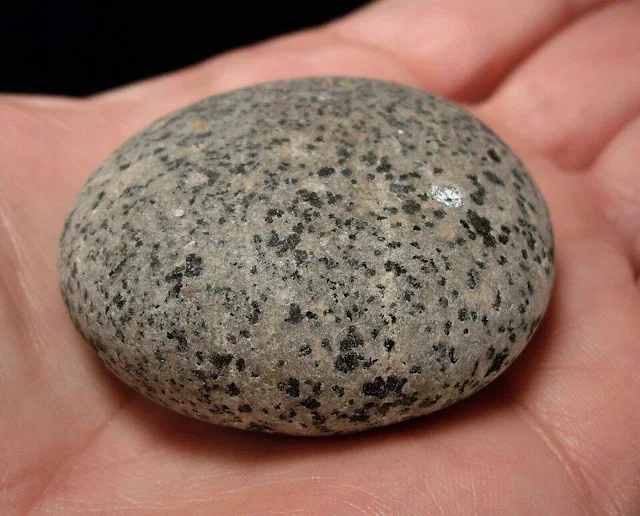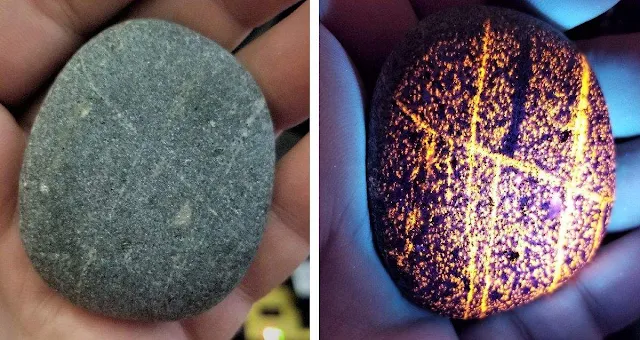Yooperlites: Glowing Rocks in Michigan
Yooperlites are a type of glowing rock found in the Upper Peninsula of Michigan, USA. They gained popularity for their unique and vibrant fluorescent properties under ultraviolet (UV) light. Yooperlites are rocks containing fluorescent sodalite, a mineral that glows orange or yellow under ultraviolet light.
The term "Yooperlite" is a combination of "Yooper," which is a colloquial term for people from the Upper Peninsula of Michigan, and "lite" referring to the fluorescence. The sodalite reacts to UV light by absorbing the energy and then re-emitting it as visible light, causing the rock to glow.
Yooperlites are actually syenite rocks, rich in minerals such as sodalite, which is responsible for their distinctive glow. When exposed to UV light, typically shortwave UV or blacklight, these rocks emit a bright orange or yellowish glow, creating a visually striking effect.
Erik Rintamaki, a resident of the Upper Peninsula, is credited with discovering and popularizing Yooperlites. He began collecting and selling these unique rocks after finding them on Lake Superior beaches.
Yooperlites are relatively young rocks, formed approximately 1.1 billion years ago during a volcanic event and subsequently transported and deposited by glaciers during the last ice age.
It's important to note that the term "Yooperlite" is specific to these fluorescent rocks found in the Upper Peninsula of Michigan, and similar rocks with fluorescent properties may be found in other locations with different names.
 |
| Yooperlites |
How Yooperlites is Formed
Yooperlites are syenite rocks that contain a mineral called sodalite, which is responsible for their fluorescent properties. The formation of Yooperlites involves geological processes that occur over long periods of time. Here's a general overview of how these rocks might form:
Magmatic Intrusion: During the Midcontinent Rift event in the Canadian Shield, a large-scale magmatic intrusion occurred, resulting in the emplacement of a syenitic pluton containing sodalite. The process begins with the intrusion of magma into the Earth's crust. Syenite is a type of igneous rock that forms from the slow cooling of this magma. The magma contains a variety of minerals, and as it cools, these minerals crystallize to form the rock.
Mineral Crystallization: Within the cooling and solidifying magma, crystallization and differentiation processes led to the formation of sodalite-syenite, incorporating fluorescent sodalite as a minor component.
Sodalite is one of the key minerals in Yooperlites. It is a rare mineral that forms as part of the crystallization process within the syenite. The presence of specific elements and conditions during crystallization leads to the formation of sodalite crystals within the syenite matrix.
Inclusions and Aggregates: Sodalite may occur as inclusions or aggregates within the syenite. The crystal structure of sodalite includes aluminum, silicon, sodium, and chlorine, among other elements.
Fluorescent Properties: The fluorescent properties of Yooperlites are due to the presence of certain activator elements within the sodalite. When exposed to ultraviolet (UV) light, these activator elements absorb energy and then re-emit it as visible light, creating the characteristic bright orange or yellowish glow.
Erosion and Exposure: Over time, geological processes such as weathering and erosion can expose these syenite rocks on the surface. As the rocks are exposed to the elements, they can be found on beaches, riverbanks, or other areas where natural forces have brought them to the surface.
 |
Yooperlites, which are a type of syenite rich in fluorescent sodalite found in the Upper Peninsula of Michigan. |
Why do Yooperlites glow
Yooperlites glow due to a phenomenon called fluorescence. Fluorescence is the emission of light by a substance that has absorbed light or other electromagnetic radiation. In the case of Yooperlites, the mineral responsible for this fluorescence is sodalite.
The key factors contributing to the glow of Yooperlites are:
Sodalite Composition:
Sodalite is a mineral with a distinct crystal structure that includes aluminum, silicon, sodium, and chlorine, among other elements.
Certain trace elements within the sodalite act as activators. These activators are responsible for absorbing energy from ultraviolet (UV) light and then re-emitting that energy as visible light.
UV Light Absorption and Re-emission:
When exposed to UV light, such as that from a blacklight or shortwave UV lamp, the sodalite in Yooperlites absorbs the UV radiation.
The absorbed energy excites the electrons in the trace elements within the sodalite, raising them to higher energy states.
Visible Light Emission:
As the excited electrons return to their lower energy states, they release the absorbed energy in the form of visible light.
This emitted light creates the vibrant orange or yellowish glow that is characteristic of Yooperlites under UV light.
Unique Fluorescent Properties:
The specific combination of minerals, trace elements, and the unique geological conditions in the Upper Peninsula of Michigan contribute to the distinctive fluorescence of Yooperlites.
The bright and colorful glow makes Yooperlites visually striking and has contributed to their popularity among rockhounding enthusiasts.
It's worth noting that not all minerals exhibit fluorescence, and the ability to fluoresce is specific to certain minerals and their chemical compositions. In the case of Yooperlites, the fluorescence of sodalite under UV light is what gives these rocks their unique and captivating appearance.
 |
| Yooperlite (sodalite syenite) in normal light |
Properties of Yooperlite
Color: Gray, pink, or tan in natural light. When exposed to ultraviolet light, they emit an orange-yellow fluorescence.
Texture: The texture of Yooperlites is generally granular to phaneritic, reflecting their igneous origin. Phaneritic rocks have visible mineral grains. Can be smooth or rough depending on polishing.
Hardness: 5.5-6 on the Mohs scale, similar to glass or steel. Can be scratched by quartz but not by a fingernail.
Mineral composition: Primarily composed of syenite, an igneous rock containing feldspar and pyroxene minerals. Additionally, they contain fluorescent sodalite, a rarer mineral responsible for the glow.
Fluorescence: Emits an orange-yellow glow under ultraviolet light with a wavelength of 365 nanometers. The intensity of the glow can vary depending on the sodalite content and other factors.
Density: Around 2.6-2.8 g/cm³, slightly denser than water.
Weathering resistance: Moderately resistant to weathering. The syenite portion is relatively stable, but the sodalite can be susceptible to weathering processes like acid rain over long periods.
Magnetism: Non-magnetic. Neither syenite nor sodalite exhibit magnetic properties.
 |
| Yooperlite photographed in normal light (left) and under UV light (right). |
Where to find Yooperlites
Yooperlites are predominantly found in the Upper Peninsula of Michigan, USA. Specifically, they are often discovered along the beaches of Lake Superior. The unique fluorescent properties of Yooperlites make them stand out when exposed to ultraviolet (UV) light, and they can be found among the rocks and pebbles along the shores of the Great Lakes.
Primary Locations:
Lake Superior Shoreline: The vast majority of Yooperlites are found along the shores of Lake Superior, particularly in the Upper Peninsula of Michigan. Popular areas include:
Grand Marais: Known for its abundance of Yooperlites, especially near Agate Beach and Sand Point Beach.
Whitefish Point: Offers a scenic search with potential for Yooperlites near the Whitefish Point Lighthouse.
Keweenaw Peninsula: The rocky shores and beaches around Copper Harbor and Eagle Harbor hold promise for Yooperlite discovery.
Gravel Pits: While less common, Yooperlites have been found in some inland gravel pits in Michigan and Minnesota. Research and permission are crucial before searching private property.
It's important to note that the specific locations where Yooperlites can be found may vary, and rockhounding enthusiasts often explore different areas to discover these unique rocks. Additionally, always be respectful of local regulations and private property rights when searching for Yooperlites or engaging in rock collecting activities.
 |
| Yooperstone Necklace |
Tips to Find Yooperlites
Look at night: Use a long-wave ultraviolet (UV) flashlight to reveal the Yooperlites' glow, which is more easily seen in darkness.
Focus on specific areas: Look near eroded cliffs, wave action zones, or areas with exposed bedrock, as these can provide fresh sources of Yooperlites.
Be respectful of regulations: Always check local regulations before collecting Yooperlites, as collecting from some public lands may be illegal.
Consider guided tours: Guided tours or workshops led by experienced rockhounds can significantly increase your chances of finding Yooperlites and provide valuable insight into their identification and responsible collection.
 |
| Yooperlite Carved Dragon |
Yooperlites Uses
Here are some potential uses and ways in which people engage with Yooperlites:
Collectibles and Souvenirs
Many people collect Yooperlites as unique and eye-catching geological specimens. They are often sought after by rockhounding enthusiasts, collectors, and those interested in unique natural phenomena.
Decorative Items
Yooperlites can be used in crafting and artistic projects. Some individuals create jewelry, sculptures, or other decorative items featuring Yooperlites to showcase their distinctive fluorescence.
Educational Purposes
Yooperlites can be used in educational settings to teach students about geology, mineralogy, and fluorescence. Their unique properties make them engaging and memorable for educational purposes.
Lapidary Arts
Lapidaries, individuals skilled in working with stones, may use Yooperlites in their craft. This can include cutting and polishing Yooperlites to create gemstones or cabochons for use in jewelry.
Cultural and Local Identity
Yooperlites have become a symbol of the Upper Peninsula of Michigan. They are embraced as a unique feature of the region, and their cultural significance is often reflected in local art, crafts, and souvenirs.
Scientific Research
While not a common use, Yooperlites may attract interest from researchers studying minerals, fluorescence, or geological processes. They could be used in scientific studies exploring the unique properties of sodalite and other minerals.
Tourism and Events
The discovery and popularity of Yooperlites have contributed to the tourism industry in the Upper Peninsula of Michigan. Events or tours focused on rockhounding and the search for Yooperlites may attract visitors interested in experiencing this unique geological phenomenon.
It's important to note that Yooperlites are not typically used for industrial or practical applications due to their composition and the specific focus on their aesthetic and fluorescent properties. Their value lies more in their beauty, uniqueness, and cultural significance.
Conclusion
Overall, Yooperlites have become a notable and sought-after geological phenomenon, celebrated for their striking fluorescence and the connection to the unique cultural identity of the Upper Peninsula of Michigan.
See also: What is Lake Superior Agate, and Where Can You Find It

%20(1).webp)






